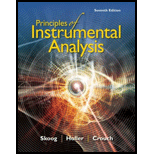
Concept explainers
Cyclohexnone exhibits its strongest IR absorption hand at 5.86
(a) Identify the part of the molecule responsible for the absorbance at this wavelength.
(b) Suggest a solvent that would be suitable for a quantitative analysis of cyclohexanone at this wavelength.
(c) A solution of cyclohexanone (4.0 mg/mL) in the solvent selected in part (b) exhibits a blank-corrected absorbance of 0.800 in a cell with a path length of 0.025 mm. What is the detection limit for this compound under these conditions if the noise associated with the spectrum of the solvent is 0.001 absorbance units?
(a)
Interpretation:
The part of the molecule that is responsible for absorbance at the given wavelength is to be stated.
Concept introduction:
The IR absorption spectroscopy makes use of a mid infrared light that detects the particular types of chemical bonds in a given sample for the purpose of the identification of organic and organomettalic compounds. In the IR absorption spectra, there are two regions: Functional group region and the fingerprint region.
Answer to Problem 17.1QAP
The part of the molecule that is responsible for absorbance at the given wavelength is Carbonyl (
Explanation of Solution
Given information:
The IR absorption band is
The expression for the wave number is:
Here, the wavelength is
Substitute
(b)
Interpretation:
A solvent that would be suitable for quantitative analysis of cyclohexanone at the given wavelength is to be stated.
Concept introduction:
Quantitative analysis refers to the determination of relative or absolute quantity of a substance in a given sample. There are several methods of carrying out the quantitative analysis of the samples. These methods include gravimetric and volumetric analysis.
Answer to Problem 17.1QAP
A solvent that would be suitable for quantitative analysis of cyclohexanone at the given wavelength is cyclohexane and any chlorinated solvent.
Explanation of Solution
The solvent that is suitable for quantitative analysis of cyclohexanone at the given wavelength should be cheap and less toxic in nature.
The solvents that can be used are cyclohexane and any chlorinated solvent.
(c)
Interpretation:
The detection limit for the compound is to be stated.
Concept introduction:
The detection limit refers to the smallest quantity of the substance that can be differentiated from the absence of that particular substance with a certain level of confidence.
Answer to Problem 17.1QAP
The detection limit for the compound is
Explanation of Solution
Given information:
Noise associated with the spectrum of the solvent is 0.001 absorbance units.
The expression for the Beer’s Law,
Here, the absorbance is
Substitute
Substitute
Divide Equation (III) by Equation (II)
Want to see more full solutions like this?
Chapter 17 Solutions
Principles of Instrumental Analysis
- Synthesize 2-Ethyl-3-methyloxirane from dimethyl(propyl)sulfonium iodide using the necessary organic or inorganic reagents. Draw the structures of the compounds.arrow_forwardSynthesize 2-Hydroxy-2-phenylacetonitrile from phenylmethanol using the necessary organic or inorganic reagents. Draw the structures of the compounds.arrow_forwardSynthesize N-Methylcyclohexylamine from cyclohexanol using the necessary organic or inorganic reagents. Draw the structures of the compounds.arrow_forward
- Synthesize N-Methylcyclohexylamine from cyclohexanol using the necessary organic or inorganic reagents. Draw the structures of the compounds.arrow_forwardIf possible, please provide the formula of the compound 3,3-dimethylbut-2-enal.arrow_forwardSynthesize 1,4-dibromobenzene from acetanilide (N-phenylacetamide) using the necessary organic or inorganic reagents. Draw the structures of the compounds.arrow_forward
- Indicate the products obtained by mixing (3-oxo-3-phenylpropyl)triphenylphosphonium bromide with sodium hydride.arrow_forwardWe mix N-ethyl-2-hexanamine with excess methyl iodide and followed by heating with aqueous Ag2O. Indicate the major products obtained.arrow_forwardIndicate the products obtained by mixing acetophenone with iodine and NaOH.arrow_forward
- Indicate the products obtained by mixing 2-Propanone and ethyllithium and performing a subsequent acid hydrolysis.arrow_forwardIndicate the products obtained if (E)-2-butenal and 3-oxo-butanenitrile are mixed with sodium ethoxide in ethanol.arrow_forwardQuestion 3 (4 points), Draw a full arrow-pushing mechanism for the following reaction Please draw all structures clearly. Note that this intramolecular cyclization is analogous to the mechanism for halohydrin formation. COH Br + HBr Brarrow_forward
 ChemistryChemistryISBN:9781305957404Author:Steven S. Zumdahl, Susan A. Zumdahl, Donald J. DeCostePublisher:Cengage Learning
ChemistryChemistryISBN:9781305957404Author:Steven S. Zumdahl, Susan A. Zumdahl, Donald J. DeCostePublisher:Cengage Learning ChemistryChemistryISBN:9781259911156Author:Raymond Chang Dr., Jason Overby ProfessorPublisher:McGraw-Hill Education
ChemistryChemistryISBN:9781259911156Author:Raymond Chang Dr., Jason Overby ProfessorPublisher:McGraw-Hill Education Principles of Instrumental AnalysisChemistryISBN:9781305577213Author:Douglas A. Skoog, F. James Holler, Stanley R. CrouchPublisher:Cengage Learning
Principles of Instrumental AnalysisChemistryISBN:9781305577213Author:Douglas A. Skoog, F. James Holler, Stanley R. CrouchPublisher:Cengage Learning Organic ChemistryChemistryISBN:9780078021558Author:Janice Gorzynski Smith Dr.Publisher:McGraw-Hill Education
Organic ChemistryChemistryISBN:9780078021558Author:Janice Gorzynski Smith Dr.Publisher:McGraw-Hill Education Chemistry: Principles and ReactionsChemistryISBN:9781305079373Author:William L. Masterton, Cecile N. HurleyPublisher:Cengage Learning
Chemistry: Principles and ReactionsChemistryISBN:9781305079373Author:William L. Masterton, Cecile N. HurleyPublisher:Cengage Learning Elementary Principles of Chemical Processes, Bind...ChemistryISBN:9781118431221Author:Richard M. Felder, Ronald W. Rousseau, Lisa G. BullardPublisher:WILEY
Elementary Principles of Chemical Processes, Bind...ChemistryISBN:9781118431221Author:Richard M. Felder, Ronald W. Rousseau, Lisa G. BullardPublisher:WILEY





